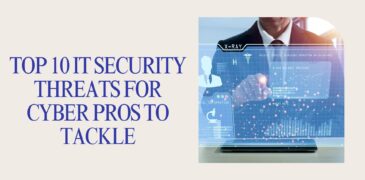As technology advances, so do the challenges in cybersecurity. In today’s digital world, IT security threats have become more sophisticated and pervasive, posing significant risks to individuals and organizations worldwide. From ransomware attacks targeting critical infrastructure to data breaches compromising sensitive information, cyber professionals face a relentless barrage of threats. This introduction sets the stage for exploring the diverse array of security challenges that cybersecurity professionals must tackle, highlighting the critical role they play in safeguarding against cyber threats and preserving the integrity and confidentiality of digital assets.
Top 10 IT Security Threats for Cyber Pros to Tackle are:
Ransomware Attacks
Ransomware attacks have emerged as a pervasive and disruptive threat in the digital landscape, demanding the attention of cybersecurity professionals globally. These attacks involve malicious software that encrypts an organization’s critical data, rendering it inaccessible until a ransom is paid to the attackers, typically in cryptocurrency. The consequences of ransomware are profound, ranging from financial losses and operational disruptions to reputational damage. Cybercriminals often target businesses, government entities, and individuals, exploiting vulnerabilities in systems or employing social engineering tactics. The evolution of ransomware includes increasingly sophisticated variants, such as double extortion, where attackers threaten to expose sensitive data if the ransom is not paid.
Phishing Scams
Phishing scams persist as a prominent threat, demanding vigilant attention from cybersecurity professionals. In these attacks, cybercriminals employ deceptive emails, messages, or websites to trick individuals into disclosing sensitive information or downloading malware. The sophistication of phishing techniques continues to evolve, making it challenging to detect and combat such threats. Cybersecurity professionals must implement robust email filtering, conduct regular awareness training, and employ advanced threat detection tools to mitigate the risks posed by phishing scams. As organizations and individuals remain primary targets, proactive measures and ongoing education are essential to fortify defenses against this persistent and socially engineered form of cyber threat.
Data Breaches
Data breaches stand as a formidable challenge for cybersecurity professionals, posing severe risks to organizations and individuals alike. These breaches involve unauthorized access to sensitive data, compromising confidentiality and potentially exposing personal or financial information. Cybersecurity experts face the complex task of securing vast amounts of data against sophisticated and persistent attackers. Breaches can result from various factors, including vulnerabilities in systems, inadequate access controls, or targeted cyber-attacks. Mitigating these threats requires a multifaceted approach, encompassing encryption, network monitoring, robust authentication mechanisms, and proactive threat intelligence.
Zero-Day Exploits
Zero-day exploits present a formidable challenge for cybersecurity professionals, representing a category of attacks that target vulnerabilities unknown to software developers. These exploits exploit security flaws before patches or updates are available, leaving systems vulnerable to unauthorized access, data breaches, and malware infections. Cybersecurity experts must be adept at discovering and mitigating these unknown threats, requiring proactive monitoring, threat intelligence analysis, and rapid response mechanisms. The race between attackers seeking to exploit zero-day vulnerabilities and defenders working to develop and deploy patches underscores the dynamic nature of cybersecurity.
Advanced Persistent Threats (APTs)
Advanced Persistent Threats (APTs) represent a sophisticated and insidious category of cyber threats that demand heightened attention from cybersecurity professionals. APTs are orchestrated by well-funded and organized adversaries, often nation-states or advanced cybercriminal groups, with the primary goal of infiltrating targeted systems and maintaining undetected access over an extended period. These attacks involve meticulous planning, leveraging advanced techniques to evade traditional security measures. Cybersecurity professionals must employ advanced threat detection tools, conduct continuous monitoring, and implement robust incident response strategies to counter APTs effectively.
IoT Vulnerabilities
The proliferation of Internet of Things (IoT) devices introduces a complex and challenging landscape for cybersecurity professionals, as IoT vulnerabilities pose significant threats. These vulnerabilities can be exploited to compromise the security and privacy of interconnected devices, leading to unauthorized access, data breaches, and potential disruptions to critical systems. Cybersecurity experts must address unique challenges in securing diverse IoT ecosystems, including weak authentication, lack of encryption, and limited update mechanisms in many IoT devices. Tackling IoT vulnerabilities requires comprehensive risk assessments, implementation of robust security protocols, and ongoing monitoring of connected devices.
Supply Chain Attacks
Supply chain attacks concern for cybersecurity professionals, requiring a strategic and comprehensive approach to defense. These attacks target vulnerabilities in the software supply chain. Aiming to compromise trusted systems by infiltrating third-party vendors or software providers. Cybersecurity experts must implement rigorous vetting processes for third-party components, monitor and verify software integrity. Enhance supply chain resilience to thwart potential breaches. The SolarWinds incident is a notable example, underscoring the far-reaching impact of such attacks. Cyber professionals must collaborate across industries, share threat intelligence, and implement robust cybersecurity measures to fortify supply chains against increasingly sophisticated adversaries.
Social Engineering
Social engineering poses a persistent and crafty threat in the realm of cybersecurity. Necessitating heightened awareness and proactive measures from cyber professionals. This tactic involves manipulating individuals to divulge sensitive information or perform actions that compromise security. Cybersecurity experts must combat a range of social engineering techniques, including phishing, pretexting, and baiting, by educating users. Implementing robust authentication protocols, and enhancing overall cybersecurity awareness. As human psychology becomes a focal point for cyber attackers, professionals must continuously evolve their defense strategies, emphasizing the human element in security measures. Establishing a culture of skepticism, conducting regular training, and fostering a security-conscious mindset are essential components of combating social engineering threats.
Cloud Security Risks
Cloud security risks have become a prominent concern for cybersecurity professionals as organizations increasingly migrate to cloud-based services. The dynamic nature of cloud environments introduces vulnerabilities such as misconfigurations, unauthorized access, and data breaches. Cybersecurity experts must address these risks through robust access controls, encryption, and continuous monitoring. Mismanaged cloud configurations can expose sensitive data to unauthorized parties, making it crucial for professionals to conduct regular audits and implement security best practices. As the attack surface expands in the cloud, proactive measures are vital to counter potential threats.
Insider Threats
Insider threats pose a nuanced and challenging risk for cybersecurity professionals to address. These threats involve malicious or unintentional actions by individuals within an organization, risking unauthorized access, data breaches, or sabotage. Cybersecurity experts must implement robust monitoring systems, conduct thorough background checks. Foster a culture of security awareness to mitigate insider threats effectively. Balancing the need for trust with proactive measures is essential.
Conclusion
In conclusion, the landscape of IT security threats presents a formidable challenge for cybersecurity professionals. From the sophisticated tactics of advanced persistent threats to the subtle manipulations of social engineering. Cyber pros face a diverse range of adversaries. Securing against supply chain vulnerabilities, IoT risks, and insider threats demands a multifaceted strategy. As organizations continue to embrace cloud technologies, addressing associated risks becomes imperative. In this ever-evolving digital terrain. Cyber professionals play a crucial role in fortifying defenses, staying ahead of evolving threats. Fostering a resilient cybersecurity ecosystem to protect sensitive data and uphold the integrity of digital infrastructures.
Read more:







